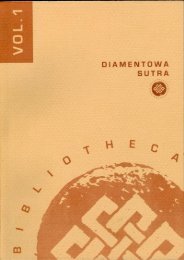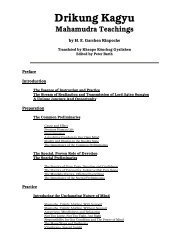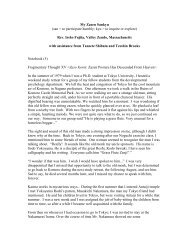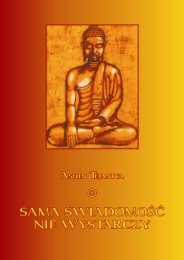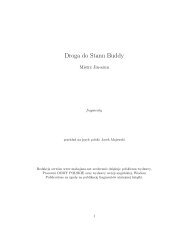3 - Computing in the Humanities and Social Sciences
3 - Computing in the Humanities and Social Sciences
3 - Computing in the Humanities and Social Sciences
Create successful ePaper yourself
Turn your PDF publications into a flip-book with our unique Google optimized e-Paper software.
game” <strong>in</strong>cessantly played on a cosmic level by <strong>the</strong> Buddha Mahåvairocana <strong>in</strong> what is<br />
known as “<strong>the</strong> preach<strong>in</strong>g by <strong>the</strong> Dharmakåya” (Jp. hossh<strong>in</strong> seppø, see Lecture 2). 13<br />
2. Shittan: The Graphologic Signifier<br />
2.1. Shittan, <strong>the</strong> Esoteric Script<br />
In orig<strong>in</strong>, mantric expressions only had a vocal function; <strong>the</strong>y were chanted, recited,<br />
mumbled, or <strong>the</strong>ir pronunciation was simulated <strong>in</strong> one’s m<strong>in</strong>d, but <strong>in</strong> any case it was<br />
<strong>the</strong>ir sound that had a primary importance. When Buddhist texts conta<strong>in</strong><strong>in</strong>g mantras,<br />
dhåra√∆, or o<strong>the</strong>r spells, where translated <strong>in</strong>to Ch<strong>in</strong>ese, <strong>the</strong>se formulae were left<br />
untranslated; <strong>the</strong>ir pronunciation was preserved as much as possible through<br />
transcription employ<strong>in</strong>g Ch<strong>in</strong>ese characters used phonetically. Mantric expression were<br />
thus, for <strong>the</strong> Ch<strong>in</strong>ese, <strong>the</strong> Koreans, <strong>and</strong> <strong>the</strong> Japanese, <strong>the</strong> sounds of a foreign language<br />
that was used primarily <strong>in</strong> order to communicate with <strong>the</strong> Buddhist deities.<br />
With <strong>the</strong> development of esoteric Buddhism, <strong>the</strong> Indian script <strong>in</strong> which Buddhist<br />
texts were written began to acquire importance <strong>in</strong> Ch<strong>in</strong>a <strong>and</strong> especially <strong>in</strong> Japan. Shittan<br />
(Ch. xitan) is <strong>the</strong> phonetic transcription of <strong>the</strong> Sanskrit siddhaµ, nom<strong>in</strong>ative s<strong>in</strong>gular<br />
neuter of <strong>the</strong> passive past participle of <strong>the</strong> verbal root sidh, “to complete.” Accord<strong>in</strong>g to<br />
as common etymological explanation, siddhaµ means “that which has been completed,”<br />
“that which is complete,” but also, by extension, “someth<strong>in</strong>g perfect.” With<strong>in</strong> esoteric<br />
Buddhism “that which is complete, perfect” refers to that which is expressible<br />
l<strong>in</strong>guistically through <strong>the</strong> siddhaµ writ<strong>in</strong>g system, as opposed to “that which is not<br />
complete,” which as a consequence is deemed “<strong>in</strong>complete,” “imperfect.” Ano<strong>the</strong>r<br />
etymology, more prosaic (but perhaps closer to <strong>the</strong> truth…), is reported by van Gulik.<br />
Accord<strong>in</strong>g to it, siddhaµ was orig<strong>in</strong>ally a popular term used to refer to <strong>the</strong> alphabet. It<br />
derived from <strong>the</strong> custom of ancient calligraphy teachers to encourage <strong>the</strong>ir pupils by<br />
<strong>in</strong>scrib<strong>in</strong>g on <strong>the</strong>ir writ<strong>in</strong>g tablets <strong>the</strong> augural expressions siddhaµ, “may you be<br />
successful!” or siddhir-astu, “good luck!” (van Gulik 1980: 54-55).<br />
13 Harvey Alper was perhaps <strong>the</strong> first to apply to mantric phenomena <strong>the</strong> idea he took from<br />
Wittgenste<strong>in</strong> of language game: Alper 1989.<br />
22



![Shushogi, Dogen Zenji [PDF] - Mahajana.net](https://img.yumpu.com/50921105/1/190x219/shushogi-dogen-zenji-pdf-mahajananet.jpg?quality=85)


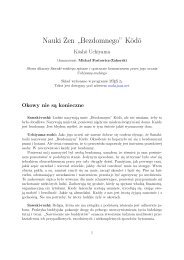

![wywiadu z Murakami Kosho Roshim [PDF] - Buddyzm w Polsce i na ...](https://img.yumpu.com/45809746/1/184x260/wywiadu-z-murakami-kosho-roshim-pdf-buddyzm-w-polsce-i-na-.jpg?quality=85)
